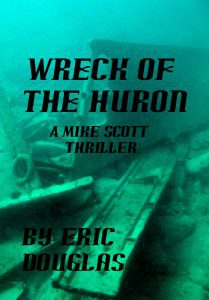 My fourth novel Wreck of the Huron is now available. It’s been nearly three years since I published my last novel (Guardian’s Keep) and it feels good to be back to telling stories again. But this story came with its own set of challenges. The incident that serves as the catalyst for the book is a real event.
My fourth novel Wreck of the Huron is now available. It’s been nearly three years since I published my last novel (Guardian’s Keep) and it feels good to be back to telling stories again. But this story came with its own set of challenges. The incident that serves as the catalyst for the book is a real event.The USS Huron is a real shipwreck located just a few hundred yards off shore in Nags Head, North Carolina. Most of Wreck of the Huron is set in the present day, but there are several scenes that are set in 1877 on board the ship on the day it sank. To tell that story and to make it as realistic as possible, I used quotes and the names and accounts from the men who survived the wreck. Those accounts were recorded in the PROCEEDINGS OF COURT OF INQUIRY ON THE LOSS OF THE HURON held by the NAVY DEPARTMENT, Washington DC, Wednesday, December 5, 1877. The wreck happened in the early morning hours on November 24, 1877.
Here is an excerpt for the account of the accident just as the ship ran aground, as retold in Wreck of the Huron:
With each wave that passed, the jarring of the hull against the bottom was lessened — only because the ship was run further aground and was lifted less and less.
“Stop the engines!” Ryan ordered from the bridge. “Palmer, find out if we still have steam in the boilers. I want to see if we can back her out of here before the hull gets holed.”
Master French pulled back on the throttle, signaling the engineer to stop the engines. Palmer left his station to yell down the hatch to the engine room below.
“Can you back her, engineer?” Palmer asked.
“We’ve got full steam on all the engines. Yes, we can,” Chief Engineer Loomis replied.
“Make it happen, Mr. Loomis,” Palmer ordered.
“Mr. French, save the ship’s log. We’ve probably foundered on Nags Head. Mr. Palmer, please sound the distress whistle. We’re going to need some help,” Ryan said, taking charge of the bridge. “Get all hands on deck and batten down the hatches. Get those sails lowered.”
Within moments, French reported back to the bridge that the captain’s office where the ship’s log was stored was filled with water, being on the starboard side.
“Very well,” Ryan acknowledged. “Lieutenant Simons, order the fore mast cut away, please. Maybe we can right this ship without the added weight.”
“I will make it happen immediately,” Simons said, leaving across the angled deck to organize the men. The Huron was over on her side, at about 40 degrees.
To be perfectly clear, aside from my own fertile imagination, the “mystery” around the sinking of the ship portrayed in this story is total fiction. These men died in service to their country and there has never been any suspicion of wrongdoing connected with the wreck. It was a tragic loss of life.
It is wrapped up in the local history of the Outer Banks of North Carolina that this wreck and one elsewhere a few months later persuaded Congress to fund the US Lifesaving Service year-round. At the time of the wreck the rescue boats and other equipment were locked up tight for the winter. That group eventually became the US Coast Guard.
The other historical setting for the story is the situation in Cuba at the time of the wreck. Cuba was in the midst of the first Cuban Revolution against Spain. They had been fighting for nine years at that point, finally calling a truce in 1878. This revolution helped bring about an end to slavery on the island eight years later. Cuba did not gain independence for Spain until the end of the Spanish American War in 1898.
In some ways writing a story like this with that sort of historical backdrop is difficult. While some authors have been known to take liberties with historical events, move things around and change dates and locations, I wanted to keep this story as close to the truth as I could. Obviously, I had to manufacture characters and scenarios. That’s the fun part of writing fiction. But I wanted it to be as true to what really happened as possible.
If you’re interested, you can read the first two chapters of Wreck of the Huron on my website. Unfortunately, neither of those chapters includes any of the historical references I’ve been talking about. To get to that part of the book, you’ll just have to get a copy for yourself.
If you do, I hope you find the mixture of real history and imagination as much fun to read as I enjoyed writing it..